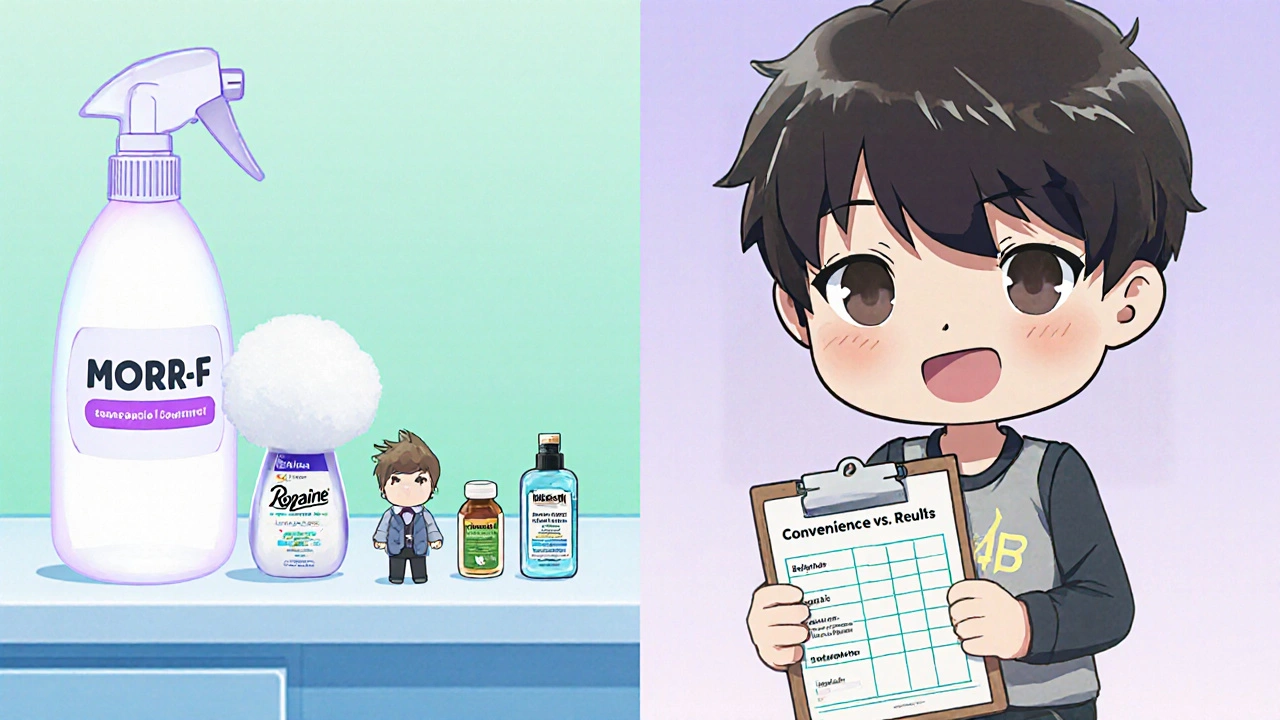Morr F vs Alternatives: Minoxidil & Finasteride Hair Loss Treatments Compared
25 Oct, 2025Compare Morr F’s minoxidil‑finasteride combo with top hair loss options, see pros, cons, costs and decide the best solution for your needs.
READ MORENoticed more hair in the shower or on your pillow? That’s stressful, but there are clear steps you can take. This page explains common causes, proven treatments, and what to expect so you can make sensible choices without getting lost in myths.
First, work out the cause. Male- or female-pattern baldness (androgenetic alopecia) is the most common reason and usually comes on slowly. Sudden shedding points to stress, illness, thyroid problems, low iron, or a medication side effect. Ask your doctor for a basic check: blood count, thyroid test, and iron level. That gives you a clear starting point and avoids wasting time on treatments that won’t help.
Start simple and safe. Topical minoxidil (available without a prescription) helps many people keep hair and sometimes regrow thin areas. Use it as directed—results take months, and you must keep using it to maintain gains. For men, oral finasteride is a well-studied option that slows hair loss and can regrow hair for many users. It’s prescription-only and has possible side effects, so talk to your doctor about risks.
If you want faster or more visible change, surgical hair transplant is an option. Modern techniques (FUE and FUT) move healthy follicles to thinning areas. It’s more expensive but gives long-lasting results when done by an experienced surgeon. Expect recovery time and a few months for new hair to grow in.
Other clinic-based treatments include PRP (platelet-rich plasma) and low-level laser therapy. PRP uses your own blood to stimulate follicles; some people see improvement, but results vary. Laser devices can help maintain thickness for some users, especially when combined with medical treatments.
Don’t overlook lifestyle fixes. Improve diet (enough protein and iron), manage stress, and avoid tight hairstyles and harsh chemical treatments. If a medication you take could be the cause, do not stop it without talking to your doctor—often there are safer alternatives or dose changes that help.
Manage expectations: most treatments take 3–6 months to show benefit. Stopping active treatment usually means losing the gains. Cost, convenience, and side effects will shape the right choice for you.
If you’re unsure where to start, book a primary care visit or see a dermatologist who treats hair loss. They’ll check for medical causes, explain options, and help you plan follow-up. Try one evidence-based treatment at a time so you can tell what’s working.
Want a quick plan? Get basic blood tests, try topical minoxidil for 6 months, and if you’re a suitable male candidate, consider finasteride after discussing risks. If results are limited, discuss PRP or a transplant with a specialist.
Take small steps and track progress with photos every month. That’s the best way to know if your hair loss treatment is moving you in the right direction.

Compare Morr F’s minoxidil‑finasteride combo with top hair loss options, see pros, cons, costs and decide the best solution for your needs.
READ MORE
This article explores eight viable alternatives to Propecia for treating hair loss, offering a comprehensive look at their benefits and drawbacks. From FDA-cleared treatments like Rogaine and Avodart to innovative therapies like Low-Level Laser Therapy and Platelet-Rich Plasma, readers will gain insights into the effectiveness, safety, and accessibility of each option. The role of natural remedies such as Saw Palmetto, as well as surgical solutions like hair transplantation, is also discussed. The aim is to equip readers with the knowledge needed to make informed decisions about their hair restoration journey. A comparison table concludes the discussion, providing a quick overview of each treatment.
READ MORE